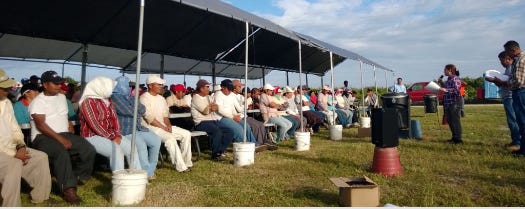How can workers protect themselves from dangerous heat exposure?
For once, some good news out of Florida!
Welcome back to Work Climate! I’m writing this on Leap Day, so we’re going to go ahead and call it the February edition :) As I’ve surveyed some already, only a handful of states have rules in place to protect workers from heat-related illness and injury, and a federal standard is still a distant prospect (though I hear rumors there may be a proposed rule published this summer). Until then, low-wage workers will continue to make up a significant number of the thousands of people (and climbing) who die from heat exposure annually in the United States. Or is that far too pessimistic an outlook?
Today, I’m interested in challenging an implicit tenet of many of the debates over regulating climate exposures: that such regulations should be primarily legal in nature. Of course, the line between law, policy, and organizing solutions is often fuzzy. Consider my previous posts on union campaigns to win heat protections and coalitional efforts to establish hazard pay for vineyard workers laboring in smoky conditions. These are examples of workers and professional organizers coming together to extract legally enforceable concessions from employers or governments. Pretty solid model, right? It’s used frequently in this space, at least, from Phoenix airport workers and USPS drivers filing complaints with OSHA to walkouts and unionization drives across the country, made possible by the National Labor Relations Act.
But what if workers could bypass government agencies, and even their bosses, altogether? That’s the thrust of the Fair Food Program (FFP), an initiative spearheaded by the Coalition of Immokalee Workers (CIW). Founded in south Florida in 1993, CIW has been behind many farmworker movements for improved wages, health and safety protections, and the elimination of forced labor. And for over a decade, FFP has played a critical role in these efforts, by convincing major food distributors — think McDonald’s, Walmart, and Whole Foods — to source their produce from farms that meet certain conditions, including allowing on-site audits by CIW, worker-to-worker education sessions, and the implementation of complaint resolution systems. FFP, which now covers dozens of farms in 10 states and 4 countries, has been widely praised for boosting wages and reducing harassment and injuries.

Recently, CIW has also generated positive attention for the heat protections that are a part of FFP, summarized here in Grist:
To protect workers, the guidelines require 10-minute breaks every two hours and access to shade and water. The program also extended the time frame during which those things must be offered, from five months to eight, reducing the amount of time that workers are exposed to the worst heat of the year. Growers also must be aware of the signs of heat stress and monitor workers for them. . . .
Workers are regularly informed of their rights, and violations can be reported to the Fair Food Program through a hotline for investigation. Heat-related complaints have grown increasingly common in recent years, and often lead to a confidential arbitration process. Such inquiries may lead to mandatory heat safety training and stipulations growers must abide by.
These measures have been called “the strongest set of workplace heat protections in the United States,” and that does not seem like hyperbole — no state can boast of comparable mechanisms, and worker-organizers like Lupe Gonzalo have written powerfully about the benefits of FFP’s rules:
It’s seeing this respect and these health and safety protections in the fields that gives me hope for the future. And I trust it, because the program was created by and is driven by people just like me — the same workers who labored under the sun, harvesting food.
So, what to make of CIW’s success story? On the one hand, it challenges those of us who may look first to government — with its slow rulemakings, poor enforcement, and political vicissitudes — to expand our horizons when imagining what transformative changes should look like. On the other, FFP still only covers about 20,000 workers, and scaling it further may depend on newly-available subsidies from the Department of Agriculture. And then there’s the larger issue of whether we should depend on the graces of massive corporations to secure labor and climate wins. Wouldn’t it be better to have a robustly enforced law, applicable across states and industries?
My answer is yes, but I am still excited to see what initiatives like FFP can accomplish at scale, without petitioning the government. Next week, CIW is putting the pressure on Wendy’s to join FFP. I would love to join them if I were in Palm Beach, but, for now, they have my full support from Palo Alto.
Thank you for reading, be back at the end of the month; may it be a happy one!


Thank you for this enlightening account, David. I hope Fair Food becomes as much a part of our vocabulary in the years ahead as Fair Trade is now.